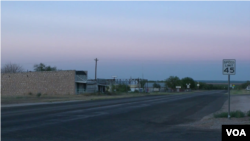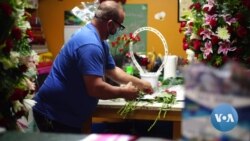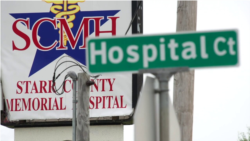For most of his life, Ross Sharp has lived in Borden County, a community in North Texas without doctors or grocery stores. Sharp said there are no strangers here, and he can probably put a name to every person in the county.
“I kind of liked the solitude. I like the people. It's home. It has that homey feel,” said Sharp, and that’s why he started a family here and never left.
Fewer than 700 people live in Borden County, and 40% of them live in Gail, a town a motorist might miss in the blink of an eye.
Sharp enjoys the friendliness of a rural town and has worn many hats here, including working as a maintenance supervisor at the Borden County school district for 30 years and now as county judge.
Coronavirus free
Proud of his community, Sharp now has one more reason to feel good about the place. No county residents have been diagnosed with COVID-19, the disease caused by the coronavirus.
However, Sharp knows that Texas, the second-largest state in the U.S., has one of the biggest COVID-19 caseloads, with more than 400,000 confirmed cases and nearly 8,000 deaths.
“That's kind of mind boggling that a neighboring town 75 miles (120 kilometers) away in a week could infect your whole county population,” Sharp said.
While ranching and oil are the county’s main industries, Sharp said its education system is also a big draw. School events anchor the county’s social life, and at least half the student body comes from outside Borden County.
“That's probably one of the major areas of concern for me is a school starting up,” he said.
High school student Austin Buchanan is anxious about the coming academic year. For about two months this spring, his classes were all online due to the coronavirus pandemic. He doesn’t know what this coming school year will be like as school officials try to plan in a fluid situation.
“This being my final year of high school, I want everything to be the way it's supposed to be, and COVID has definitely affected that,” Buchanan said.
He participates in every sport the school offers, but counties surrounding Gail have had reported confirmed cases of COVID-19. If schools in those counties go virtual, it's unclear what will happen with team athletics.
Richard Buchanan, Austin’s father and his math teacher, said he hopes students will attend classes in person.
“The social aspect of school, I think, is so important and especially in a rural community because you might not see your kids, your friends ever, you know, living 20 miles from school and on a farm … it's tough,” Richard Buchanan said.
Yet Borden County’s rural life has kept its residents coronavirus-free.
“The idea of social distance … it's kind of our norm here. … We weren’t in town every day. We weren't around lots of people every day. Some people think it's a burden, and lately it's been a blessing.” Richard Buchanan said.
Although there are no confirmed cases of COVID-19 in Gail, life has changed.
“Everyone is definitely cautious, even though we are COVID-free, we want to stay COVID-free, and that adds another layer of cautiousness,” said Austin Buchanan, who knows someone whose grandfather has died of COVID-19.
Many Gail residents now wear masks when they go to other communities, even to the grocery store 50 kilometers away.
“We try to do our best not to get exposed and bring it here,” Richard Buchanan said.
Sharp appreciates his community’s COVID-free status but feels “it's a matter of time before it (COVID-19) comes here. I'm concerned about the movement of people in and out,” he said. “I feel good about what our people do, but it's the people from the outside that concern me the most.”
Nationwide, the U.S. has 4.7 million confirmed COVID-19 cases and nearly 157,000 deaths.
South Texas town
More than 850 kilometers away from Gail, in the Rio Grande Valley of south Texas, Veronica Gonzalez faces a different reality.
While many retailers in the U.S. have been struggling or have closed, the flower shop Gonzalez owns is booming as COVID-19 is “increasing our business, unfortunately.”
“It’s already 7 p.m. and we’ve got funeral sprays to deliver tomorrow,” said Gonzalez, whose shop is only three blocks from the U.S.-Mexico border.
Gonzalez lives in the Texas border town of Roma, with a population of less than 12,000.
The coronavirus has ravaged Roma and surrounding communities in Starr County, a Latino-majority county that is one of the state’s poorest. Out of necessity, large, multigenerational families often live together.
The area also has some of the highest rates of diabetes and obesity in the Texas, so people with those diseases who contract COVID-19 are at high risk of complications.
But during the first two months of the U.S. lockdown, Starr County had very few confirmed cases, rarely more than three a day.
From mid-April to May, there were “21 straight days without any single positive case in Starr County,” Dr. Jose Vasquez, an internist and the Starr County health authority, said.
“We had kept it very cool for the first couple of months. I think it just exploded,” florist Gonzalez said.
The surge
Starr County’s battle with COVID-19 began toward the end of April, when Texas started reopening its businesses. A surge in cases followed, accelerated by two holiday weekends and Father’s Day.
“We definitely noticed” the increased number of cases given the "family reunions, barbeques outside, pool parties,” Vasquez said.
With only one hospital and fewer than two doctors for every 10,000 people, COVID-19 quickly overwhelmed the county’s health care system.
In July, the county’s top official announced on Facebook that doctors were going to have to decide who received treatment and who would be sent home to die.
Vasquez said that did not happen, after state and federal governments intervened. The Navy sent two medical teams. The San Antonio veterans’ hospital began admitting Starr County patients.
More than 20 Starr County residents have died of COVID-19, but paperwork delays hide the true toll, which includes “multiple fatalities within families,” Vasquez said.
Further taxing Starr County Memorial Hospital is the arrival of COVID-19 patients from Mexico. None are turned away.
“For us, every patient counts the same,” Vasquez said.
Gonzalez will do her part by creating floral arrangements to help comfort those who are grieving for their lost loved ones.
“It’s been a ride,” she said. “It’s very overwhelming.”
Jeremy Gossett contributed to this article from Gail, Texas.








